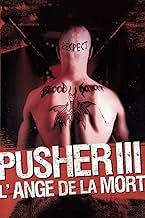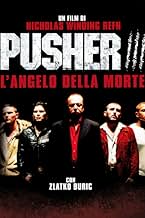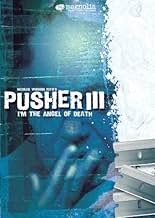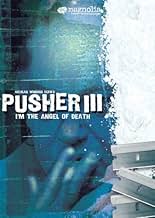ÉVALUATION IMDb
7,3/10
20 k
MA NOTE
Milo essaie d'être père de famille et de diriger son organisation criminelle, mais une mauvaise cargaison de drogue met tout en danger.Milo essaie d'être père de famille et de diriger son organisation criminelle, mais une mauvaise cargaison de drogue met tout en danger.Milo essaie d'être père de famille et de diriger son organisation criminelle, mais une mauvaise cargaison de drogue met tout en danger.
Vasilije Bojicic
- Branco
- (as Vanja Bajicic)
Avis en vedette
Pusher 3
Directed by Nicolas Winding Refn (2005)
"Hvem jeg er? F*cking King of Copenhagen!"
This is the final part of Nicolas Winding Refn's "Pusher Trilogy" a movie series about the life of three different persons with a relationship to one another. In the first of three movies Pusher (1996) we follow the drug dealer Frank and his problems when he drops a big deal. In the same movie we meet Frank's friend the bum Tonny and Frank's supplier Milo. In Pusher II (2004) we followed Tonny's life after he comes out of jail, and in Pusher 3 it is Milo's character that is the leading character.
The movie follows one day in Milo's life. He is helping planning his grownup daughter's birthday party and he has a major drug deal going on. But something in the deal goes wrong when Milo is tricked by his "partner". Milo now stands between the men he owes money and the man who owes him money. To solve all his problems Milo has to make some drastic and dramatic decisions and do some gruesome things. This includes among other things involving his old friend Radovan, known from "Pusher".
Pusher 3 is a great finish to Refn's series about the Copenhagen drug world. Zlatko Buric is amazing in his first leading role, as the old drug dealer/supplier Milo. If you liked his role and performance in Pusher, you will love him here! The movie has some very disturbing scenes and the cinematography helps the movie to appear very realistic. This movie shows a scary environment, interesting and frightening characters and contains a disturbing story.
8/10
Directed by Nicolas Winding Refn (2005)
"Hvem jeg er? F*cking King of Copenhagen!"
This is the final part of Nicolas Winding Refn's "Pusher Trilogy" a movie series about the life of three different persons with a relationship to one another. In the first of three movies Pusher (1996) we follow the drug dealer Frank and his problems when he drops a big deal. In the same movie we meet Frank's friend the bum Tonny and Frank's supplier Milo. In Pusher II (2004) we followed Tonny's life after he comes out of jail, and in Pusher 3 it is Milo's character that is the leading character.
The movie follows one day in Milo's life. He is helping planning his grownup daughter's birthday party and he has a major drug deal going on. But something in the deal goes wrong when Milo is tricked by his "partner". Milo now stands between the men he owes money and the man who owes him money. To solve all his problems Milo has to make some drastic and dramatic decisions and do some gruesome things. This includes among other things involving his old friend Radovan, known from "Pusher".
Pusher 3 is a great finish to Refn's series about the Copenhagen drug world. Zlatko Buric is amazing in his first leading role, as the old drug dealer/supplier Milo. If you liked his role and performance in Pusher, you will love him here! The movie has some very disturbing scenes and the cinematography helps the movie to appear very realistic. This movie shows a scary environment, interesting and frightening characters and contains a disturbing story.
8/10
'The third part of Nicolas Winding Refn's Pusher trilogy is clearly the best. With each part, Refn's approach becomes more daring and complex. However talented his debut from 1996 was, and however innovative the second part, this third part has a charged emotionalism that is difficult to beat, along with tension and courage. I'm the Angel of Death - Pusher III focuses on the Serbian drugs baron Milo. In earlier parts, he was an extra, a feared power lurking in the background. He is not some grand godfather, and as a middle-ranking boss he has also been on the decline for some time, yet he should not be underestimated as an adversary. At first, he seems to allow himself to be trifled with. His spoiled daughter is very demanding in everything on her birthday. His gangster sidekicks have been put out of action by food poisoning - as a result of Milo's cooking. Albanian crooks cheekily try to take over his dealing turf. He obediently attends meetings of Addicts Anonymous, afraid of returning to his old ways. But don't trifle with Milo. Or you will come to a bloody end. With his trilogy, and certainly with this last part, Refn has not only succeeded in renewing the gangster genre, but also providing it with a new geography. The American mean streets have been convincingly replaced by the multi-ethnic pavements of a Europe that has not yet been given the profile it deserves.'
quoted from: film festival Rotterdam (2006), GJZ
I couldn't agree more. Go see this film. Sharing 'downfall' as the central theme, it's better than Scarface and even more realistic about non-Hollywood gangster life than the Sopranos.
quoted from: film festival Rotterdam (2006), GJZ
I couldn't agree more. Go see this film. Sharing 'downfall' as the central theme, it's better than Scarface and even more realistic about non-Hollywood gangster life than the Sopranos.
Come take a look at the violence and depravity that goes on in ... Copenhagen.
Copenhagen? Yup. But this is pretty effin' far from Hans Christian Anderson and the Little Mermaid.
This movie caps Nicolas Winding Refn's gangster trilogy and veers off in a somewhat different direction from the first two. "Pusher I" and "Pusher II" were tense and violent movies about the Danish drug trade, but both had an element of comedy.
By contrast, Pusher III is one of the darkest movies I've ever seen and it has an extended scene at the end that would never, ever be allowed in a mainstream Hollywood gangster movie.
Pusher III happens in a 24-hour period as we follow along with Milo, a mid-level drug kingpin who is apparently a Serb. Milo has a busy day ahead of him. His daughter's 25th birthday is that evening and he's promised to cook food for 50 people. His product supplier got shipments mixed up and sent Milo 10,000 ecstasy tabs instead of the usual heroin. He's withdrawing from heroin himself and drops in at NA meetings during the day. His crew is getting ornery, giving him lip all the time.
Sigh. It's hard out there for a gangster. You almost feel sorry for the schlub.
Then, when a Polish pimp shows up wanting cash in exchange for a badly frightened 18-year-old girl he has in tow, things start to go bad.
This is in no sense of the word an action movie, although there are murders. No guns, either. It's remarkable how directors from outside the U.S. can take material Americans are completely familiar with and make it look completely different. Take the Korean monster movie "The Host" and the Swedish vampire movie "Let the Right One In." Familiar material. Brand new take.
"Pusher III"is like that. It has stretches where not much happens. But it builds to a horrifying climax all the more horrifying because it plays out utterly matter of fact.
And props to Zlatko Buric, who plays Milo. The camera is on him for the entire movie and we get to know every seam in his weary face.
Copenhagen? Yup. But this is pretty effin' far from Hans Christian Anderson and the Little Mermaid.
This movie caps Nicolas Winding Refn's gangster trilogy and veers off in a somewhat different direction from the first two. "Pusher I" and "Pusher II" were tense and violent movies about the Danish drug trade, but both had an element of comedy.
By contrast, Pusher III is one of the darkest movies I've ever seen and it has an extended scene at the end that would never, ever be allowed in a mainstream Hollywood gangster movie.
Pusher III happens in a 24-hour period as we follow along with Milo, a mid-level drug kingpin who is apparently a Serb. Milo has a busy day ahead of him. His daughter's 25th birthday is that evening and he's promised to cook food for 50 people. His product supplier got shipments mixed up and sent Milo 10,000 ecstasy tabs instead of the usual heroin. He's withdrawing from heroin himself and drops in at NA meetings during the day. His crew is getting ornery, giving him lip all the time.
Sigh. It's hard out there for a gangster. You almost feel sorry for the schlub.
Then, when a Polish pimp shows up wanting cash in exchange for a badly frightened 18-year-old girl he has in tow, things start to go bad.
This is in no sense of the word an action movie, although there are murders. No guns, either. It's remarkable how directors from outside the U.S. can take material Americans are completely familiar with and make it look completely different. Take the Korean monster movie "The Host" and the Swedish vampire movie "Let the Right One In." Familiar material. Brand new take.
"Pusher III"is like that. It has stretches where not much happens. But it builds to a horrifying climax all the more horrifying because it plays out utterly matter of fact.
And props to Zlatko Buric, who plays Milo. The camera is on him for the entire movie and we get to know every seam in his weary face.
Storyline: 10 years have passed since the first PUSHER movie. Big-time drug dealer Milo (Zlatko Buric) is stressed. Milo attempts to quit heroin by attending Narcotics Anonymous meetings, a shipment supposed to contain brown heroin turns out to contain 10.000 ecstasy-pills, and it's his daughter Milena's (Marinela Dekic) 25th birthday, and Milo has promised to cook food for her 50 guests. Little Muhammed (Ilyas Agac) leaves with the ecstasy-pills to sell them for Milo, but soon Milo can't find him, and the Albanian-Danish gangsters who smuggled the ecstasy-pills into Denmark are stressing Milo for their money. Conidentially Milo meets Kusse-Kurt (Kurt Nielsen) who slips him a small amount of heroin. Soon Milo's finds himself in a spiral of bad decisions smoking heroin, sniffing speed and murdering gangsters. Is Milo's drug empire finally crumbling?
Each installment of Nicolas Winding Refn's docu-drama trilogy tells a story from Copenhagen's underworld, but from three completely different protagonists' POV's. PUSHER tells the story of middle-level pusher Frank (Kim Bodnia), PUSHER 2 tells the story of low-level criminal Tonny (Mads Mikkelsen), and PUSHER 3 tells the story of high-level pusher Milo (Zlatko Buric). The clear message of the trilogy is: you live by the sword, you die by the sword. All three movies end on very ambivalent notes. Frank gets killed... or perhaps he doesn't. Tonny breaks loose of his dead-end lifestyle... or perhaps he doesn't. And Milo's drug empire crumbles... or perhaps it doesn't. That's how life is. It doesn't just stop. Each movie keeps evolving in your head even after they've ended, similar to John Cassavetes' movies or Danny Boyles' 1996 masterpiece TRAINSPOTTING. It's certainly something one doesnn't experience in braindead Hollywood blockbusters nowadays.
Nicolas Winding Refn's PUSHER trilogy is obviously inspired by John Cassevetes' movie-making style as they are more instinctive than intellectual, because the audience goes through the same turbulent emotions as Milo, whether it's melancholy, joy or bitterness. It's not a very fast-paced movie (except for a few breath-taking scenes), but Refn manages to maintain an uneasy tension that keeps the audience on the edge of the seats. It reflects Refn's love for his (three-dimensional) characters. Refn's 95% non-Danish dialog (the cast mainly consists of immigrants) is somewhere in-between Quentin Tarantino and John Cassavetes: very self-conscious, yet also natural and realistic. The foreign languages only adds to the mysteriousness and danger of these immigrant gangsters.
The cast primarily consists of unprofessional actors, some even with semi-criminal backgrounds, and, naturally the great Zlatko Buric whom Refn has called "the new Dirch Passer". Buric brilliantly brings out Milo's two-face ambivalence and vulnerability of an aging man in a constantly changing milieu. Refn gets performances from the unprofessional cast that range from acceptable to great -- they all add to the realness and authenticity. Many of them, of course, more or less play their real life-themselves. Many of the PUSHER characters keep re-occurring throughout the trilogy. For example: Milo (Zlatko Buric) has a supporting-role in PUSHER, a cameo-role in PUSHER 2 and the main-role in PUSHER 3. Tonny (Mads Mikkelsen) has a supporting-role in PUSHER and the main-role in PUSHER 2. Kusse-Kurt (Kurt Nielsen) has a supporting-role in PUSHER 2 and a cameo-role in PUSHER 3. This provides a feeling of continuity to the trilogy's milieu.
Peter Peter (ex-member of the legendary Danish rock-group Sort Sol) has again composed the music in collaboration with Kyed. Although I preferred the 80's-synth-inspired score in PUSHER 2, this time it's effective, bleak and minimal. For example: When Kusse-Kurt slips Milo a small amount of heroin in the grill-bar, shortly after a disturbing, noisy, distorted guitar-riff begins clashing repeatedly with 4 second intervals. It underlines Milo's desperate mind-state. One minute later Milo walks into the restroom to smoke the heroin, where the clashing guitar sound slowly transforms into a beautiful, melancholic piano-tune to underline the heroin's effect on Milo. It's a good example of subtle use of music as a movie-language.
Refn's love for so-called trashy genre-flicks shows through-out his work. Although his movies (the PUSHER trilogy, BLEEDER and FEAR X) are more art-house than genre-pieces, they are loaded with references to his favorite obscure movies, most noticeably in BLEEDER. But also PUSHER 3 contains a subtle reference, probably not known to most audiences. The climax-scene in-which Radovan (Slavko Labovic) slices up the body hanging form the ceiling is an obvious homage to one of Refn's favorite-movies Paul Morrissey's FLESH FOR FRANKENSTEIN from 1973 starring Udo Kier. FLESH FOR FRANKENSTEIN is a an original twist on the Frankenstein franchise with necrophiliac undertones. Refn borrows his climax from the climax of FLESH FOR FRANKENSTEIN: the music, the chains slowly pulling the body up, the depraved depiction of human-flesh etc. As they say, the best directors borrow from their favorite-directors.
Although all three installment are semi-masterpieces I personally prefer PUSHER 3 by a few inches. It's more honest, more disturbing, and more experimental. I have experienced the first-mentioned first-hand, as I spend years in the drug milieu. Refn's PUSHER trilogy is a street-level counterpart to Martin Scorsese's gangster trilogy (consisting of MEAN STREETS from 1973, GOODFELLAS from 1990, and CASINO from 1995), because both trilogies portray the crime underworld from low-level, middle-level and high-level gangsters' POV's. I highly recommend PUSHER 3 especially if you enjoyed its successors, although, the re-occurring characters aside, it's not completely necessary to watch the prequels before experiencing this gem, but I recommend doing so. Watch it! 9/10
Each installment of Nicolas Winding Refn's docu-drama trilogy tells a story from Copenhagen's underworld, but from three completely different protagonists' POV's. PUSHER tells the story of middle-level pusher Frank (Kim Bodnia), PUSHER 2 tells the story of low-level criminal Tonny (Mads Mikkelsen), and PUSHER 3 tells the story of high-level pusher Milo (Zlatko Buric). The clear message of the trilogy is: you live by the sword, you die by the sword. All three movies end on very ambivalent notes. Frank gets killed... or perhaps he doesn't. Tonny breaks loose of his dead-end lifestyle... or perhaps he doesn't. And Milo's drug empire crumbles... or perhaps it doesn't. That's how life is. It doesn't just stop. Each movie keeps evolving in your head even after they've ended, similar to John Cassavetes' movies or Danny Boyles' 1996 masterpiece TRAINSPOTTING. It's certainly something one doesnn't experience in braindead Hollywood blockbusters nowadays.
Nicolas Winding Refn's PUSHER trilogy is obviously inspired by John Cassevetes' movie-making style as they are more instinctive than intellectual, because the audience goes through the same turbulent emotions as Milo, whether it's melancholy, joy or bitterness. It's not a very fast-paced movie (except for a few breath-taking scenes), but Refn manages to maintain an uneasy tension that keeps the audience on the edge of the seats. It reflects Refn's love for his (three-dimensional) characters. Refn's 95% non-Danish dialog (the cast mainly consists of immigrants) is somewhere in-between Quentin Tarantino and John Cassavetes: very self-conscious, yet also natural and realistic. The foreign languages only adds to the mysteriousness and danger of these immigrant gangsters.
The cast primarily consists of unprofessional actors, some even with semi-criminal backgrounds, and, naturally the great Zlatko Buric whom Refn has called "the new Dirch Passer". Buric brilliantly brings out Milo's two-face ambivalence and vulnerability of an aging man in a constantly changing milieu. Refn gets performances from the unprofessional cast that range from acceptable to great -- they all add to the realness and authenticity. Many of them, of course, more or less play their real life-themselves. Many of the PUSHER characters keep re-occurring throughout the trilogy. For example: Milo (Zlatko Buric) has a supporting-role in PUSHER, a cameo-role in PUSHER 2 and the main-role in PUSHER 3. Tonny (Mads Mikkelsen) has a supporting-role in PUSHER and the main-role in PUSHER 2. Kusse-Kurt (Kurt Nielsen) has a supporting-role in PUSHER 2 and a cameo-role in PUSHER 3. This provides a feeling of continuity to the trilogy's milieu.
Peter Peter (ex-member of the legendary Danish rock-group Sort Sol) has again composed the music in collaboration with Kyed. Although I preferred the 80's-synth-inspired score in PUSHER 2, this time it's effective, bleak and minimal. For example: When Kusse-Kurt slips Milo a small amount of heroin in the grill-bar, shortly after a disturbing, noisy, distorted guitar-riff begins clashing repeatedly with 4 second intervals. It underlines Milo's desperate mind-state. One minute later Milo walks into the restroom to smoke the heroin, where the clashing guitar sound slowly transforms into a beautiful, melancholic piano-tune to underline the heroin's effect on Milo. It's a good example of subtle use of music as a movie-language.
Refn's love for so-called trashy genre-flicks shows through-out his work. Although his movies (the PUSHER trilogy, BLEEDER and FEAR X) are more art-house than genre-pieces, they are loaded with references to his favorite obscure movies, most noticeably in BLEEDER. But also PUSHER 3 contains a subtle reference, probably not known to most audiences. The climax-scene in-which Radovan (Slavko Labovic) slices up the body hanging form the ceiling is an obvious homage to one of Refn's favorite-movies Paul Morrissey's FLESH FOR FRANKENSTEIN from 1973 starring Udo Kier. FLESH FOR FRANKENSTEIN is a an original twist on the Frankenstein franchise with necrophiliac undertones. Refn borrows his climax from the climax of FLESH FOR FRANKENSTEIN: the music, the chains slowly pulling the body up, the depraved depiction of human-flesh etc. As they say, the best directors borrow from their favorite-directors.
Although all three installment are semi-masterpieces I personally prefer PUSHER 3 by a few inches. It's more honest, more disturbing, and more experimental. I have experienced the first-mentioned first-hand, as I spend years in the drug milieu. Refn's PUSHER trilogy is a street-level counterpart to Martin Scorsese's gangster trilogy (consisting of MEAN STREETS from 1973, GOODFELLAS from 1990, and CASINO from 1995), because both trilogies portray the crime underworld from low-level, middle-level and high-level gangsters' POV's. I highly recommend PUSHER 3 especially if you enjoyed its successors, although, the re-occurring characters aside, it's not completely necessary to watch the prequels before experiencing this gem, but I recommend doing so. Watch it! 9/10
This film is a portrait of a gangster boss. We witness the downfall of the once so cool and untouchable Milo that we got to know in the first Pusher film. Milo is trying to maintain his position in the competitive dopemarket of Copenhagen, but times are changing and younger generations are taking over. On top of this, Milo is trying to quit using dope himself and is attending meetings in Narcotics Anonymous, and he is trying to be a good father to his daughter and make her birthday party a good one.
Nicolas Winding Refn has a way of making my stomach twist and turn like no other director. I can watch gore and splatter films no problem, but the cold and cynical violence in the Pusher gets to me, because it is set in a, for me, very realistic environment. I'm not sure that I like it, but one thing is for sure; it works. The character descriptions are, as always, very believable. The mixing of a lot of the different languages of the different gangs is a funny feature, that I like. Technically, the hand-held camera works okay, but it's not the best. Music and lighting effects are great.
The film is not as good as the first Pusher film, but it has its moments, Zlatko Buric is enjoyable every second, gore is for gore-lovers, the Pusher "mood" is there and it is a fine ending of a remarkable and original trilogy that the danish film scene can be proud of.
Nicolas Winding Refn has a way of making my stomach twist and turn like no other director. I can watch gore and splatter films no problem, but the cold and cynical violence in the Pusher gets to me, because it is set in a, for me, very realistic environment. I'm not sure that I like it, but one thing is for sure; it works. The character descriptions are, as always, very believable. The mixing of a lot of the different languages of the different gangs is a funny feature, that I like. Technically, the hand-held camera works okay, but it's not the best. Music and lighting effects are great.
The film is not as good as the first Pusher film, but it has its moments, Zlatko Buric is enjoyable every second, gore is for gore-lovers, the Pusher "mood" is there and it is a fine ending of a remarkable and original trilogy that the danish film scene can be proud of.
Le saviez-vous
- AnecdotesIt was because of the criticism this film recieved in Denmark that Nicolas Winding Refn decided to stop making films there.
- GaffesWhen Milo is speaking at his daughters birthday party, the type of glass he is holding changes twice.
- ConnexionsFeatured in NWR (Nicolas Winding Refn) (2012)
Meilleurs choix
Connectez-vous pour évaluer et surveiller les recommandations personnalisées
- How long is Pusher III?Propulsé par Alexa
Détails
- Date de sortie
- Pays d’origine
- Sites officiels
- Langues
- Aussi connu sous le nom de
- I'm the Angel of Death: Pusher III
- Lieux de tournage
- sociétés de production
- Consultez plus de crédits d'entreprise sur IMDbPro
Box-office
- Brut – États-Unis et Canada
- 1 605 $ US
- Fin de semaine d'ouverture – États-Unis et Canada
- 1 792 $ US
- 20 août 2006
- Brut – à l'échelle mondiale
- 1 605 $ US
- Durée
- 1h 48m(108 min)
- Couleur
- Mixage
- Rapport de forme
- 1.85 : 1
Contribuer à cette page
Suggérer une modification ou ajouter du contenu manquant



























